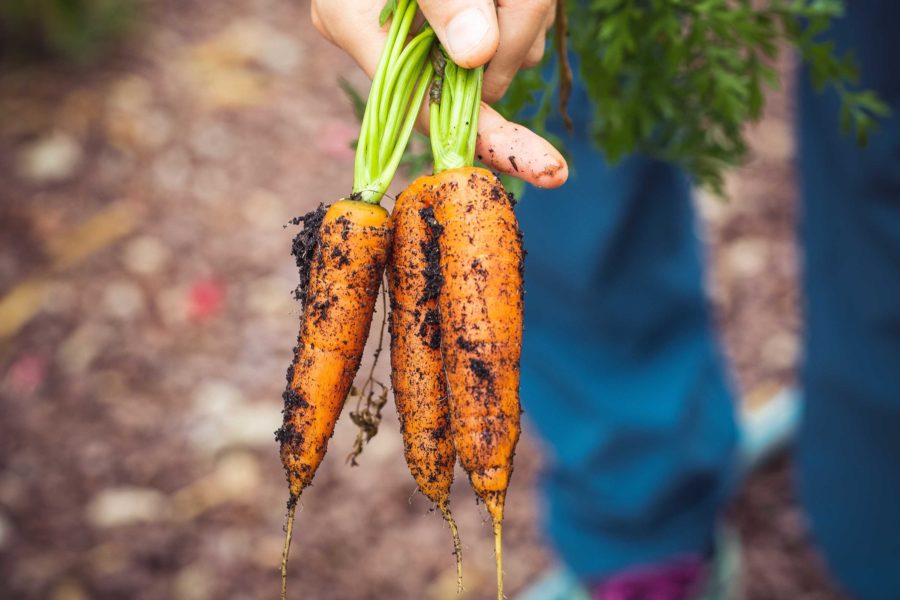Picture this: You gently nudge tomato seeds into the soil, sunlight grazing your skin. You take a moment to admire your bright pink geraniums already starting to bud and your basil leaves coming along nicely. You feel productive and at peace.
This scenario isn’t just painted across the front cover of the gardening magazine sitting in the waiting room of your dentist’s office. It can easily be your reality, even if you don’t live in a rural area with a spacious yard.
Gardening takes time and care, yes, but the (literal) fruits of your labor are tangible in many different ways and the best part is, whether you’re a beginner or a novice, you can garden just about anywhere — even in the middle of a city like Boston.
Jessie Banhazl, CEO and founder of Green City Growers, found her passion in urban farming after spending some time working in television production for reality shows. Today, she helps others grow their own food.
“I wanted to do work that’s good for people and had a positive impact on the world,” she says. “I also realized how important it was for me to have green space, be outdoors and have access to fresh food.”
One of the great benefits of gardening is how therapeutic it is. In fact, it requires us to spend time outdoors and away from our computer screens, offering a healthy dose of fresh air and vitamin D.
Gardening also involves light physical activity — incidentally, ideal for seniors who wish to remain active — and can be very meditative.
Green City Growers organized an employee engagement program for workers at local corporations such as Verizon and National Grid. Participants who completed 1,000 hours of gardening work responded favorably.
To be exact, 75 percent of 24 participants said they were less stressed, 79 percent reported eating more fruits and vegetables, and 92 percent said they had found a greater sense of community at their workplace.
“From the perspective of growing your own food, it can be really rewarding,” adds Banhazl. “Knowing you can take something from a seed, plant it, and watch it grow into sustenance and fuel for your body is hugely valuable.”
Here’s How to Get Started
Don’t be scared off if you don’t have any experience with gardening or urban farming. Your first step is to consider the three main elements necessary to grow any plant: sunlight, soil and water.
You need at least six hours of sunlight to grow most vegetables, according to Banhazl, although “certain vegetables, like leafy greens, will grow with four to six hours of sunlight.”
Once you’ve identified a spot in your home to grow your garden, either indoors or outdoors, check the amount of sunlight hitting the spot with an app called Sun Seeker. By inputting your exact location on this app, you can track the sun’s hourly direction intervals, sunrise and sunset times, and where the sun’s shadow will hit.
In most urban settings, including Boston, there’s a lack of natural healthy soil. There are usually contaminants, such as lead, that has seeped into the soil, from years of industrial development. It’s not an ideal condition for growing edible plants.
For this reason, Banhazl recommends growing your garden in a container or raised bed, and buying an organic soil mix available at your local garden stores. If you’re growing non-edible plants, you can also amend your soil by adding things like compost.
University of Massachusetts Amherst’s Center for Agriculture, Food and the Environment will test your soil in its lab. All you need to do is send a sample and the lab will test for heavy metals and provide information on how modify your soil to grow the plants you want.
Lastly, consider your access to water and your ability to bring it out to your garden on a regular basis. Rainwater usually gets the job done, but on those dry days, you will need to water your plants yourself — and if they are edible, then the water you use needs to be safe for drinking.
If growing your own full-fledged vegetable garden sounds daunting, there are starter plants that are typically easy to grow and can still be a significant source of fresh food.
“Herbs are usually the number one plant we recommend for starting out,” says Banhazl, naming herbs such as mint, thyme, and basil as examples. “They’re practical and very easy.”
Growing plants indoors is another possibility, as some plants even thrive in shade conditions. Houseplants are usually low-key options, says Banhazl. “There are hundreds of different houseplants that have different criteria in terms of sunlight and water.”
Keeping plants in your home allows for more fresh oxygen to flow throughout your space and brightens up any place, says Banhazl. “Houseplants are addicting.”



 4 min read
4 min read



